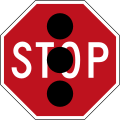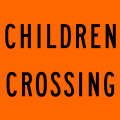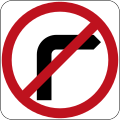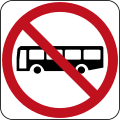User:Cassowary/road signs in Australia
Road Signs in Australia are regulated by state governments but largely standardised throughout the country by Australian standard AS1743. Since 1999, differences in new signs are almost entirely limited to typographical or linguistic variation. Australian road signs show considerable similarity to American road signs, but because there are no international agreements, there is less similarity than between European countries.
This article describes the current Australian road signs. many pre-1999 state-specific signs still exist but can easily be understood due to the similar iconography and/or words. Note that traffic in Australia drives on the left.
Stop, give way and crossings
- Stop signs
-
Stop"
-
stop when traffic lights are off or flashing
-
hand-held stop sign (can also be colored red)
-
stop on red signal
- General giveway signs
-
Give way
-
Give way at a roundabout (give way to your right)
- Specialised giveway signs
-
cyclists give way to trams
-
pedestrians give way to trams
-
give way to trams
-
give way to cyclists
-
give way to stock
- Pedestrian crossing signs
-
Pedestrian crossing
-
childrens crossing flag
The pedestrian crossing sign is used at zebra crossings. The unusual format for an Australian regulatory sign is because this sign comes from a system used before the 1970s in which all regulatory signs were yellow and circular. Only this sign and the "safety zone" sign below still have this format.
The Childrens crossing flag is attached to red-and-white striped posts when children are arriving at or leaving school.
Mga palatandaan ng bilis
Unlike in other countries which use red rings in speed limit signs, Australian speed limit signs are rectangular. This is because when the country converted to metric units, stickers showing the metric speed limit in the new style were placed on top of the old speed limit signs in miles per hour, which looked similar to current American speed limit signs.
In Australia, the red ring is not used for any other purpose and is strongly associated with speed limits (prohibition signs always contain a slash, and the European "no entry from either side" sign is replaced either with a "no entry" sign or a "road closed" sign). See for instance the "new speed limit ahead" warning sign.
- regulatory Speed limits
-
Regular 60 km/h speed limit sign
-
End 60 km/h speed limit sign (speed limit reverts to default)
-
Speed derestriction sign (speed limit reverts to default) Effectively becoming very rare in Australia nowdays
-
40 km/h speed limit sign at certain times (common in shopping areas)
-
40 km/h area (zone)
-
End 40 km/h speed limit area
-
Begin 10 km/h speed limit shared zone
-
End 10 km/h speed limit shared zone
-
Large 40 km/h school zone speed limit sign
- Speed limit warning signs
-
Sign warning of a 40 km/h speed limit ahead
-
Sign warning of a changed speed limit ahead
Prohibitions
- Directional prohibitions
-
No Parking
-
No Stopping
-
No Standing (New South Wales)
-
No Stopping (New South Wales)
-
No Entry
-
No Entry (New South Wales)
-
No Left Turn
-
No Left Turn (New South Wales)
-
No Right Turn
-
No Right Turn (New South Wales)
-
No U Turn
-
No U Turn (New South Wales)
- Other prohibitions
-
No trucks
-
No buses
-
No cyclists
-
No pedestrians
-
No overtaking or passing. Overtaking refers to travel in the same direction; passing refers to travel in the opposite direction.
-
No overtaking on bridge
Tieni la sinistra
- Mandatory directions
-
Keep left
-
Keep right. Rarely used because Australia drives on the left.
-
Avoid. Usually used when two roads diverge.
-
Safety zone: In effect "keep lefT, authorised vehicles excepted", used at tram stops in the centre of the road. These are usually put above a keep left sign and/or a hook turn sign on the one board.
- Mandatory directions per lane
-
Left lane must turn left
-
Right lane must turn right
-
Hook turn sign
- Traffic direction
-
One way
-
two way
A one way sign more similar to the one used internationaly (a black background, with a white arrow and the words "one way" in it) is commonly seen, but has been deprecated by the one shown, and is subject to replacement. The regulatory two-way sign shown here is mostly used in service roads. A two-way warning sign is commonly used at the end of a divided road.
- Mandatory turns for all traffic
-
Left turn only
-
Stragiht only
-
Right turn only
The last group are used more rarely in Australia than in Europe. Instead, directional prohibition signs are used. In some states, older variants of these signs can be seen with "all" or "All traffic" instead of "only".
Restricted lanes
Restricted lanes are have signs with the word “LANE” on them. Traffic may use these lanes within 100 metres of making a turn, so long as they do not delay the type of traffic they are intended for.
Exclusive lanes
Exclusive lanes have signs with the word “ONLY” on them. Other traffic may not use exclusive lanes at all.
ciao ciao ciao per la visione
Lines on the road
Because it rarely snows in Australia, many lines on the road will be used to indicate things which are indicated by signs in the European system: In particular, priority is indicated entirely by a continuation of lane and centre-of-road lines, and overtaking restrictions are rarely signed.






















































